Ryutaro Hashimoto facts for kids
Quick facts for kids
Ryūtarō Hashimoto
Senior Second Rank
|
|
|---|---|
|
橋本 龍太郎
|
|
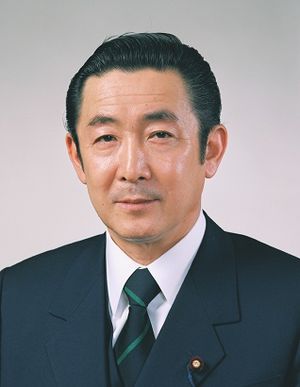 |
|
| Prime Minister of Japan | |
| In office 11 January 1996 – 30 July 1998 |
|
| Monarch | Akihito |
| Deputy | Wataru Kubo |
| Preceded by | Tomiichi Murayama |
| Succeeded by | Keizō Obuchi |
| Deputy Prime Minister of Japan | |
| In office 2 October 1995 – 11 January 1996 |
|
| Prime Minister | Tomiichi Murayama |
| Preceded by | Yōhei Kōno |
| Succeeded by | Wataru Kubo |
| Minister of Finance | |
| In office 28 January 1998 – 30 January 1998 |
|
| Prime Minister | Himself |
| Preceded by | Hiroshi Mitsuzuka |
| Succeeded by | Hikaru Matsunaga |
| In office 10 August 1989 – 14 October 1991 |
|
| Prime Minister | Toshiki Kaifu |
| Preceded by | Tatsuo Murayama |
| Succeeded by | Toshiki Kaifu |
| Minister of Economy, Trade and Industry | |
| In office 30 June 1994 – 11 January 1996 |
|
| Prime Minister | Tomiichi Murayama |
| Preceded by | Eijiro Hata |
| Succeeded by | Shunpei Tsukahara |
| Minister of Transport | |
| In office 22 July 1986 – 6 November 1987 |
|
| Prime Minister | Yasuhiro Nakasone |
| Preceded by | Hiroshi Mitsuzuka |
| Succeeded by | Shintaro Ishihara |
| Minister of Health | |
| In office 7 December 1978 – 9 November 1979 |
|
| Prime Minister | Masayoshi Ōhira |
| Preceded by | Tatsuo Ozawa |
| Succeeded by | Kyoichi Noro |
| Member of the House of Representatives for Okayama 4th District Okayama 2nd District (1963-1996) |
|
| In office 21 November 1963 – 11 September 2005 |
|
| Personal details | |
| Born | 29 July 1937 Sōja, Okayama, Empire of Japan |
| Died | 1 July 2006 (aged 68) Tokyo, Japan |
| Political party | Liberal Democratic Party |
| Children | Gaku Hashimoto |
| Alma mater | Keio University |
| Signature |  |
Ryutaro Hashimoto (橋本 龍太郎, Hashimoto Ryūtarō, 29 July 1937 – 1 July 2006) was a Japanese politician. He served as the Prime Minister of Japan from 1996 to 1998. He was a very important leader within the LDP, which was the main ruling party in Japan. He remained a powerful figure in Japanese politics for many years. He passed away on July 1, 2006, in Tokyo.
Contents
Ryūtarō Hashimoto's Early Career in Politics
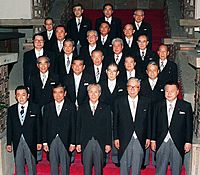
Ryūtarō Hashimoto was born on July 29, 1937, in Sōja, Okayama Prefecture. His father, Ryōgo Hashimoto, was also a government minister. Following his father's path, Ryūtarō studied political science at Keio University. In 1963, he was elected to the House of Representatives of Japan, which is a part of Japan's parliament.
Over the next 20 years, he moved up in the Liberal Democratic Party. In 1978, he became the Minister of Health and Welfare. In 1980, he took on a key role in the LDP's finance and public administration. He became a cabinet minister again in 1986. In 1989, he became the secretary general of the LDP. This was a very high position, just below the party president.
Hashimoto became a major figure in a strong LDP group. In 1991, there were reports that one of his assistants was involved in a financial issue. Hashimoto then stepped down as Minister of Finance. After Japan's economy faced difficulties in the early 1990s, the LDP briefly lost power. However, Hashimoto returned to the cabinet in 1994. He became the Minister of International Trade and Industry in the government led by Tomiichi Murayama. In this role, Hashimoto became well-known at international meetings.
In September 1995, Hashimoto won the election to become the LDP president. He succeeded Yōhei Kōno as the party leader and also became the deputy prime minister.
Ryūtarō Hashimoto: Japan's Prime Minister
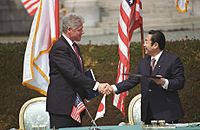
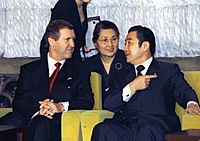
When Prime Minister Murayama resigned in 1996, the Japanese parliament elected Hashimoto to be the 82nd Prime Minister of Japan. He continued to lead a government made up of a few different parties.
In April 1996, Hashimoto reached an important agreement with the United States. This agreement was about returning a US military base in Okinawa, called MCAS Futenma, to Japan. This base was in a busy city area and caused some problems for the local people. Even though some Japanese officials were against it, President Bill Clinton supported the deal. As of 2015, the base has not yet been fully returned because people in Okinawa have protested against moving it to another location.
Hashimoto's popularity grew during a trade disagreement between Japan and the US. He openly discussed the issues with the US Trade Representative, Mickey Kantor. When asked why Japanese car dealerships didn't sell American cars, he famously replied, "Why doesn't IBM sell Fujitsu computers?" This showed his strong and direct style.
Japan's economy was struggling after 1991. Hashimoto asked a group of experts to find ways to improve the Japanese market and make it more open to foreign businesses.
In September 1996, Hashimoto's government called for a new election for the lower house of the National Diet. In the election that followed, the LDP gained more seats. This allowed the LDP to form a government on its own, which was the first time since 1993. With this success, Hashimoto was confirmed as the party president again in September 1997.
In 1997, Hashimoto's government increased Japan's consumption tax. Even though they lowered income taxes before this, the increase in consumption tax made people buy less. This had a negative effect on the economy.
In the 1998 election for the Upper House, the LDP lost more seats. Because of this, Hashimoto resigned as Prime Minister. He took responsibility for the election results. Keizō Obuchi, who was the Foreign Minister, then became the new LDP president and Prime Minister.
Later Political Life and Global Work
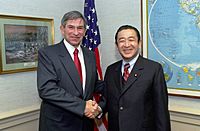
After his time as Prime Minister, Hashimoto remained an important adviser in the LDP. He also served as a minister in charge of Okinawa development and administrative reform in a later government. In 2001, he was a top candidate to become prime minister again, but he lost to the very popular Junichiro Koizumi.
In December 2004, Hashimoto stepped down as a leader of his political group. This happened after it was found that he had accepted money from a dental association. He then announced that he would not run for re-election in the next general election.
On World Water Day in 2004, the United Nations Secretary-General, Kofi Annan, created a group to advise on water and sanitation issues. Ryūtarō Hashimoto was chosen to lead this group. Before he passed away, Hashimoto wrote a letter to "The People of the World." In this letter, he talked about water-related disasters around the world. He asked the United Nations to work towards cutting the number of deaths from water disasters in half by 2015. He ended his letter with an old saying: "Dripping water wears away the stone." He meant that with steady effort, we can overcome big challenges.
Family
Ryūtarō Hashimoto was married to Kumiko Hashimoto.
His half-brother, Daijiro Hashimoto, was a former governor of Kōchi Prefecture.
His second son, Gaku Hashimoto, is also a member of the House of Representatives and the Liberal Democratic Party.
Honours
- Grand Cordon of the Order of the Chrysanthemum (awarded after his death in 2006)
- Senior Second Rank (awarded after his death in 2006)
- Golden Pheasant Award from the Scout Association of Japan (1992)
Personal Interests
Hashimoto was very skilled in Kendo, which is a Japanese martial art similar to fencing. He achieved a high rank, called a sixth degree black belt (6th dan). In 1998, he gave two trophies to a Kendo tournament at Harvard University to encourage the participants.
An exchange program between the Scout Association of Japan and the Boy Scouts of America started in 1998. This idea came from Prime Minister Hashimoto himself, after a meeting with US President Bill Clinton in 1996. In 1998, he received the Silver World Award from the Boy Scouts of America. This award was given for his great work helping young people around the world.
In 1999, Hashimoto appeared as a judge on the Japanese TV show Iron Chef. He was a judge for the final cooking competition.
Images for kids
See also
 In Spanish: Ryūtarō Hashimoto para niños
In Spanish: Ryūtarō Hashimoto para niños


